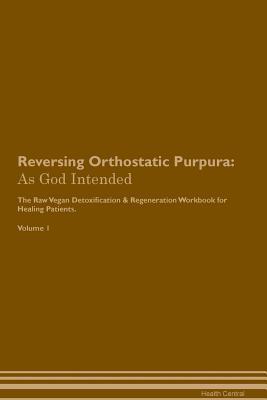Read online Reversing Orthostatic Purpura: As God Intended The Raw Vegan Plant-Based Detoxification & Regeneration Workbook for Healing Patients. Volume 1 - Health Central | PDF
Related searches:
Orthostatic Hypotension - NORD (National Organization for Rare
Reversing Orthostatic Purpura: As God Intended The Raw Vegan Plant-Based Detoxification & Regeneration Workbook for Healing Patients. Volume 1
Mixed Cryoglobulinemia - NORD (National Organization for Rare
Dear mayo clinic: what is postural tachycardia syndrome, and how is it diagnosed?can it be treated, or do you just have to live with it? answer: a diagnosis of postural tachycardia syndrome, commonly known as pots, typically is based on symptoms, along with the results of an assessment called a tilt table test.
Com provides accurate and independent information on more than 24,000 prescription drugs, over-the-counter medicines and natural products. This material is provided for educational purposes only and is not intended for medical advice, diagnosis or treatment.
Orthostatic hypotension is a chronic, debilitating illness that is difficult to treat. The therapeutic goal is to improve postural symptoms, standing time, and function.
Orthostatic hypotension — also called postural hypotension — is a form of low blood pressure that happens when you stand up from sitting or lying down. Orthostatic hypotension can make you feel dizzy or lightheaded, and maybe even cause you to faint. Orthostatic hypotension may be mild, and episodes can last for less than a few minutes.
Pots is diagnosed only when orthostatic hypotension is ruled out and when there is no acute dehydration or blood loss.
Clinical pharmacology studies have demonstrated the beta-blocking activity of metoprolol, as shown by (1) reduction in heart rate and cardiac output at rest and upon exercise, (2) reduction of systolic blood pressure upon exercise, (3) inhibition of isoproterenol-induced tachycardia, and (4) reduction of reflex orthostatic tachycardia.
27 oct 2020 if you have this form of low blood pressure, you might feel dizzy or lightheaded or you might faint when you rise from sitting or lying down.
Numerous small lesions the size of pinpricks (petechaie) may develop. Purpuric lesions are most common after an affected individual has been standing or sitting for long periods of time (orthostatic purpura).
I also have pots [postural orthostatic tachycardia syndrome] and ist [inappropriate sinus tachycardia]. The treatments kind of contradict each other and it’s making this winter particularly difficult. I finally found medication that controls my tachycardia well and i don’t want to undo that.
16 jul 2015 it is a heterogenous condition with orthostatic intolerance due to dysautonomia and is characterised by rise in heart rate above 30 bpm from base.
As a community, we have also experienced our dark days, shedding tears for our loved ones gone to life eternal, praying with and for our families struggling with loss, illness, brokenness and all those things that belong to this fallen and broken world.
Purpura is the color of a dye extracted from a mollusk found on the shores of the city of tyre in ancient phoenicia (contemporarily in lebanon), which color in classical antiquity was a symbol of royalty and political authority because only the very wealthy could afford it, including the roman emperors.
11 oct 2016 although autonomic dysfunction may even reflect early signs of neurodegeneration, the long follow-up duration of our study renders reverse.
We present the case of a 39-year-old man with epigastric pain, nausea and vomiting. The patient scored 4 in the visual triage checklist of acute respiratory symptoms; a covid-19 swab was taken. Prompt review of the peripheral blood smear showed evidence of microangiopathic haemolytic anaemia and thrombocytopenia. Because the patient had a picture of thrombotic thrombocytopenic purpura, plasma.
Annular telangiectatic purpura, eczematoid purpura, shamberg's disease, the wicked purple, purple pigment lichenoid dermatitis, arcuate telangiectatic purpura, white skin atrophy, purple pigment angiodermitis, orthostatic purpura, netted senile hemosiderosis.
Orthostatic hypotension (oh) and neurogenic orthostatic hypotension (noh) are characterized as a drop in blood pressure that can dizziness or fainting.

Post Your Comments: